   
The Greatest Math Teacher EverEach year, the MAA recognizes great university teachers of mathematics. Anybody who has been involved in selecting a colleague for a teaching award will know that it is an extremely difficult task. There is no universally agreed upon, ability-based linear ordering of mathematics teachers, even in a single state in a given year. How much more difficult it might be then to choose a "greatest ever university teacher of mathematics." But if you base your decision on which university teacher of mathematics has had (through his or her teaching) the greatest impact on the field of mathematics, then there does seem to be an obvious winner. Who is it?Having stated the problem, I should perhaps add that this column is really directed at mathematicians (and those simply interested in mathematics) under the age of 40. Most of us who have been in mathematics for over twenty years probably know the answer. Let me give you some clues as to the individual who, I am suggesting, could justifiably be described as the American university mathematician who, through his (it's a man) teaching, has had the greatest impact on the field of mathematics. He died twenty-five years ago at the age of 91. He was cut in the classic mold of the larger-than-life American hero: strong, athletic, fit, strikingly good looking, and married to a beautiful wife (in the familiar Hollywood sense). He was well able to handle himself in a fist fight, an expert shot with a pistol, a lover of fast cars, self-confident and self-reliant, and fiercely independent. Opinionated and fiercely strong-willed, he was forever embroiled in controversy. He was extremely polite; for example, he would always stand up when a lady entered the room. He was a pioneer in one of the most important branches of mathematics in the twentieth century. He was a elected to membership of the National Academy of Science, as were three of his students. The method of teaching he developed is now named after him. If you measure teaching quality in terms of the product - the successful students - our man has no competition for the title of the greatest ever math teacher. During his 64 year career as a professor of mathematics, he supervised fifty successful doctoral students. Of those fifty Ph.D.'s, three went on to become presidents of the AMS - a position our man himself held at one point - and three others vice-presidents, and five became presidents of the MAA. Many more pursued highly successful careers in mathematics, achieving influential positions in the AMS and the MAA, producing successful Ph.D. students of their own and helping shape the development of American mathematics as it rose to its present-day position of world dominance. In the last half-century, fully 25% of the time the president of the MAA has been either a student or a grandstudent of this man. Other students and grandstudents of our mystery mathematician have served as secretary, treasurer, or executive director of one of the two mathematical organizations and have been editors of leading mathematical journals. After reaching the age of 70, the official retirement age for professors at his university, in 1952, he not only continued to teach at the university, he continued to teach a maximum lecture load of five courses a year - more than most full-time junior faculty took on. He did so despite receiving only a half-time salary, the maximum that state regulations allowed for someone past retirement age who for special reasons was kept on in a "part-time capacity. He maintained that punishing schedule for a further eighteen years, producing 24 of his 50 successful Ph.D. students during that period. He only gave up in 1969, when, after a long and bitter battle, he was quite literally forced to retire. In 1967, the American Mathematical Monthly published the results of a national survey giving the average number of publications of doctorates in mathematics who graduated between 1950 and 1959. The three highest figures were 6.3 publications per doctorate from Tulane University, 5.44 from Harvard, and 4.96 from the University of Chicago. During that same period, our mathematician's students averaged 7.1. What makes this figure the more remarkable is that our man had reached the official retirement age just after to the start of the period in question. Who was he? I'll give you the answer next month.
Devlin's Angle is updated at the beginning of each month. |

